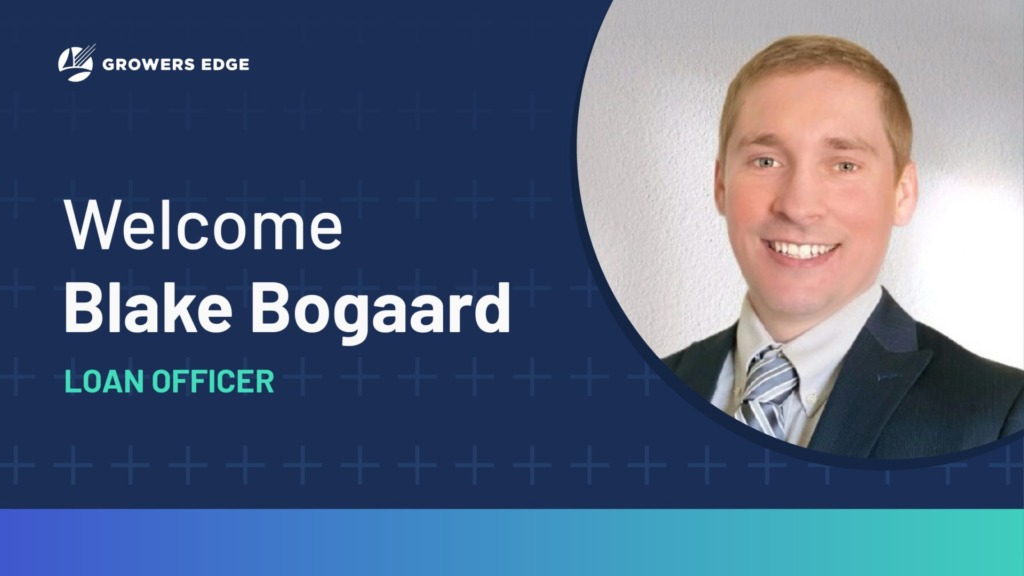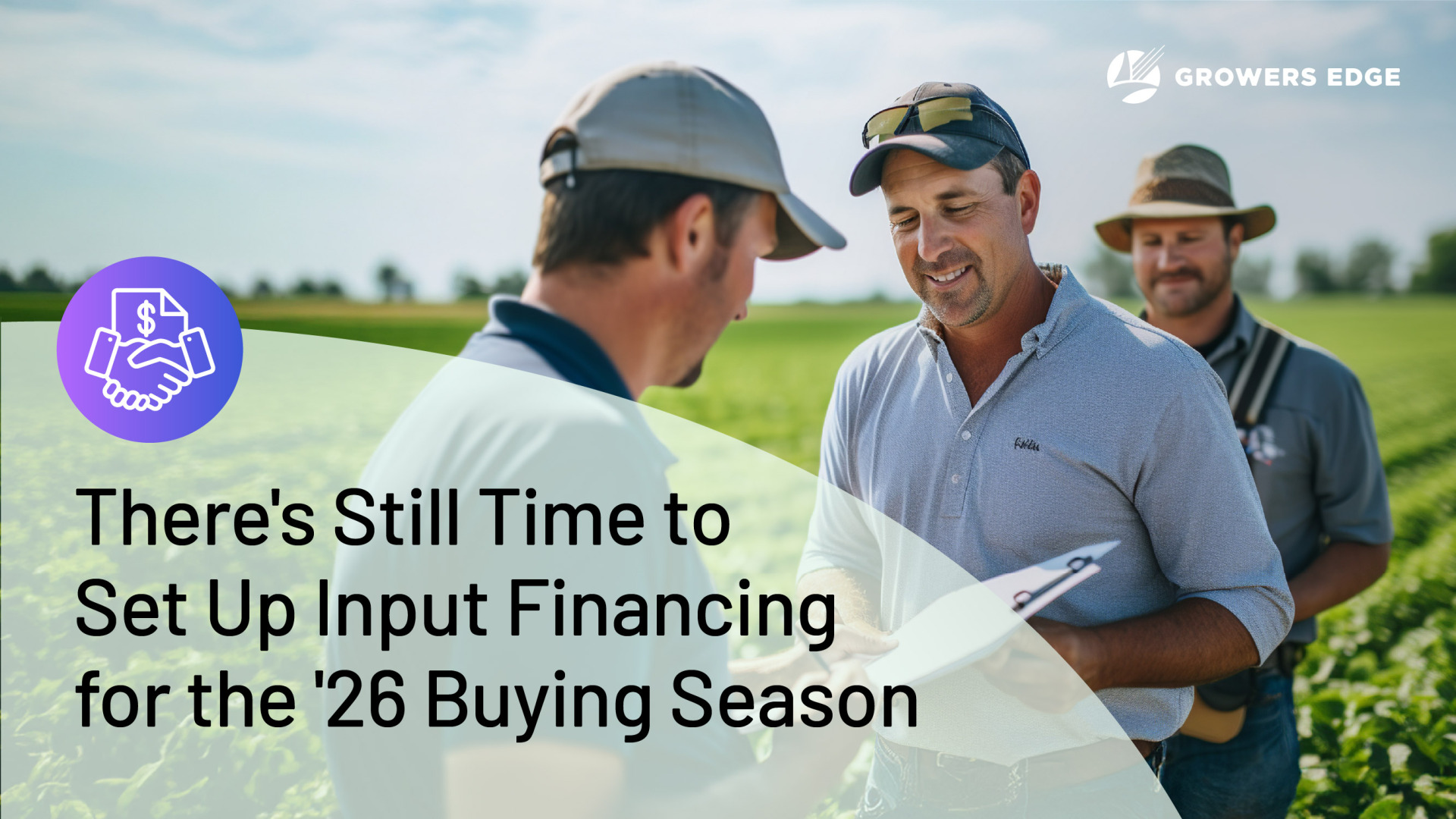
One thing Blake Bogaard hates hearing: “That’s how we’ve always done it.” For example: you’re trying to close a loan for a farmer. You send them a template to fill out (income, collateral, debts, etc.). You then follow up 17 times, because the farmer doesn’t have 30 spare minutes to fill out all the info.
Blake, who has a background in accounting, management, and lending, sees processes like this and immediately tries to find a better way.
For example: pull a balance sheet you’ve worked with the farmer on in the past. Fill out everything you can, then send that version of the template along and ask if it looks correct.
As a loan officer with the mortgage arm of Growers Edge, he’s found a place that embraces this way of working. Instead of hearing “that’s how we’ve always done it,” Blake finds himself encouraged to ask, “How can we do this better?”
Already, the question is paying off.
Building a Better Ag Lending Model from the Ground Up
Blake joined Growers Edge this spring after three years with Farmers Business Network (FBN), where he was a top producer. Prior to his work in ag lending, he worked for two years as an accountant.
This background gives him a unique perspective on lending: “Many loan officers who haven’t done the tax or accounting side – they don’t know what a balance sheet should even look like,” he said. But with his background, he knows instinctively that asking about that document can provide valuable insight for a lender.
What’s more, his familiarity with the accounting side of things gives him a unique perspective into what might make ag lending work better, for both the lenders and the farmers they’re trying to help.
And that, he said, is one reason he’s so enthusiastic about his work at Growers Edge.
“I trust that if I’m willing to fight for the farmer, and they say, ‘This is my situation, this is what I need. Can you do it?’ It’s never a yes or no,” he said. “It’s always, ‘Let’s get the financials and see if it makes sense.”
For Blake, finding creative ways to make things work – for both Growers Edge’s financial partners and the farmers they’re teaming up to serve – is the most exciting part of the job.
And that’s a top priority for Growers Edge as well. The leadership listens to teammates like Blake and quickly acts on their recommendations. This is part of what makes us more efficient and more relevant than others in the market.
Innovation Mindset + Supportive Partners
Of course, there’s a reason most traditional ag lenders default to “how they’ve always done it.” Banks and farm credits aren’t in the business of innovation. They’re in the business of minimizing risk – in some ways, innovation’s polar opposite.
For Blake, that’s part of the appeal of being an early hire on the Growers Edge ag lending team. As a fintech company, Growers Edge is explicitly in the business of innovation: we’re trying to create better ways of financing the things farmers need, from land to crop inputs.
And our financial partners, including FarmerMac on the mortgage side, are similarly enthusiastic about the mission.
Today, much of Blake’s work involves rekindling relationships he had in previous lending roles – and that’s intentional. Growers Edge plans to maintain long-term relationships with the farmers we serve. That means, for one thing, that we gladly share the risk with our financial partners – we’re not just acting as a referral source.
Downstream, of course, that means we’re incredibly motivated to develop innovative ag lending models that work for everyone involved.
Serving Farmers with Diverse Needs from Around the Country
Part of what Blake likes about his role at Growers Edge is that the new lending models he’s working on have the potential to benefit farmers around the US.
“The biggest difference between this work and my LO roles at banks is that, with banking, you’re working with your community, however many counties,” he said. “At Growers Edge, our goal is to appeal to anyone who needs ag financing.”
Already, he’s been working with farmers around the country, from vineyard operators in California to ranchers in Texas and New Mexico to farmers in Maryland and everyone in between.
And he’s not just helping those who fit the pigeonhole of farm credit. As an early member of the mortgage team, he’s helping build better, more customized products that can help farmers in a variety of circumstances do what they want to do. Whether they’re younger growers, interested in doing organic farming, trying to raise diversified crops, or otherwise farming in such a way that makes it difficult to work through traditional channels, Blake and the Growers Edge team want to help.
In a Tough Farming Economy, Innovation Is Essential
After years of skyrocketing commodity prices and input costs, commodity prices have fallen – but input costs haven’t. Cashflows are tight. A lot of banks are stepping back from ag lending because the financials no longer make sense for their legacy models.
This is why innovation in the ag finance space is so crucial right now. Farmers still need funds to purchase their inputs; they’ll need operating lines in the fall. When they want to buy land, they’ll need mortgages. All of those real-world things have to happen – that’s how the rest of us eat.
So how can we enable it? How can we build better financial products that work for both the realities of farmers on the ground and the demands of financial partners? Those are the questions Blake is working on every day. The answers he and the team come up with will fuel the next generation of agriculture.








